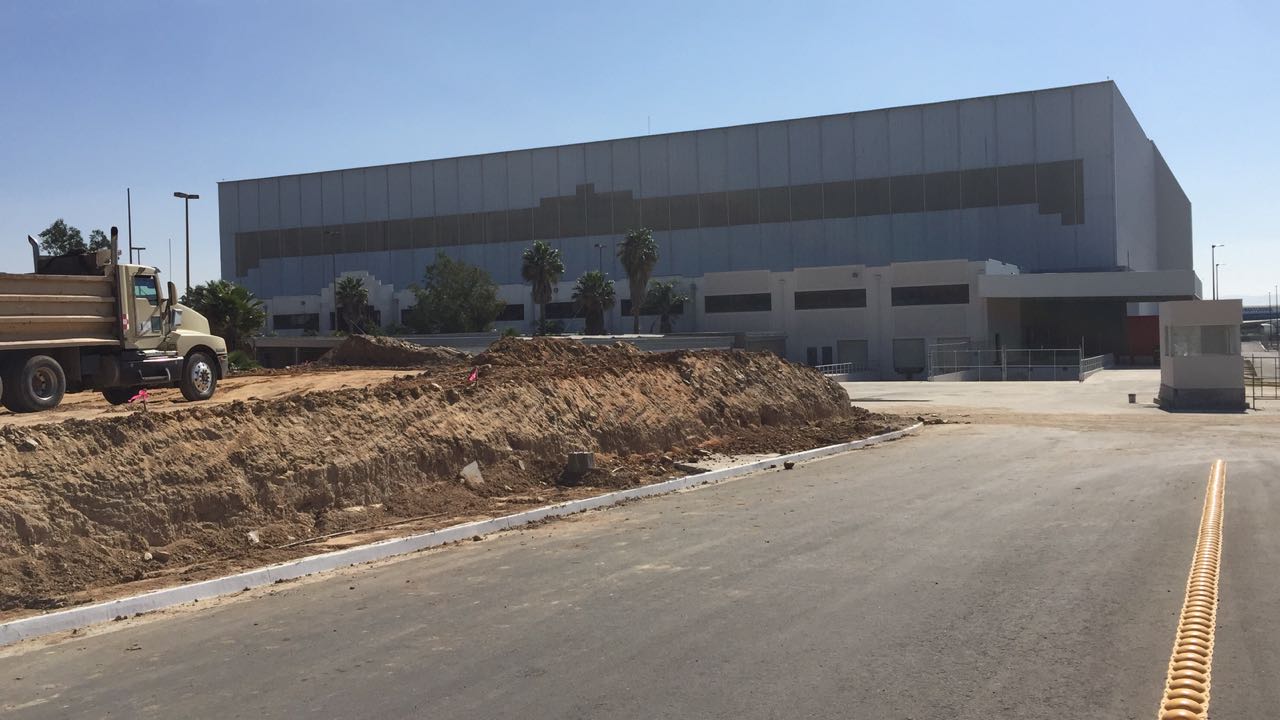A new air cargo park set to open in Tijuana could not only boost trade relations between Mexico and Asia, but provide San Diego with another major commercial connection to its southern neighbor.
Along with other major infrastructure projects and border crossings, the cargo facility is yet another fortification increasing San Diego’s economic relationship with Mexico. It’s a welcome development to trade advocates at a time when the future of cross-border commerce is uncertain.
In March, the air cargo and logistics facility will begin operation adjacent to the Tijuana International Airport. The roughly 64-acre air cargo park was built by a subsidiary of Grupo Bustamante, the real estate and development company of former Tijuana Mayor Carlos Bustamante.
Bustamante said the air cargo park will make it easier to move goods between Asia and Latin America, serving companies such as FedEx, UPS, DHL, Estafeta, Aeromexico, and Volaris Cargo. It will include on-site Mexican customs authorities, a bonded warehouse, office space for freight forwarders, customs agents, banking services, food concessions and the Mexican Postal Service.
“There’s been an increased amount of Chinese investment in South America and Mexico,” said Jock O’Connoll, an International Trade Advisor at Beacon Economics. “There’s a lot of competition for playing the same kind of role Panamanians do in becoming a key transit point for shipments by ship and airplane between the Far East and South and Central America.”
Such a facility would permit Latin America to more easily trade directly with Asia. Now they often must go through the United States, making trade between the regions more expensive and timely, O’Connoll said.
Concerns over the growing trade relationship between Mexico, and the rest of Latin America, and China have been at the forefront during the Trump presidency, with the United States withdrawal from the Trans-Pacific Partnership and pending negotiations over the future of the North American Free Trade Agreement
U.S. Secretary of State Rex Tillerson even warned Latin American leaders about the dangers of the region’s increased trade with China earlier this month, which, reports the Guardian, puzzled many experts who think that the Trump administration is all but pushing our southern neighbors into China’s arms.
The air cargo center will facilitate the relationship by reducing the region’s dependence on U.S. airports to receive and send goods to Asia.
Most air cargo flies in the belly of passenger flights and will enter Mexico through commercial flights between Asia and Tijuana, then be processed in the facility and dispersed to other locations throughout the country, Latin America and even Southern California by truck, rail or flight.
Tijuana is the closest airport in Mexico to Asia. Most flights that continue to other parts of Latin America from Asia stop at Tijuana before continuing to Mexico City and various other parts of the region.
The number of flights between Asia and Tijuana has also been growing. A second airline recently announced it would begin flights between Beijing and Tijuana in three months, according to the Tijuana Press.
Increased air cargo and trade between Tijuana and Asia will also increase the number of passenger flights between Tijuana and Asia because air cargo often travels in commercial airplanes. That means San Diegans who want to travel to Asia could soon shop for flights from not only San Diego and Los Angeles but Tijuana too, through the cross-border airport facility.
“It’s a very novel project in Mexico,” Bustamante said. Now the only airports in the country that can receive international cargo are Mexico City, Guadalajara, Toluca, Monterrey and Cancun, which leaves vast swaths of the country that trade internationally reliant on trucks to move goods, which is less efficient.
Eduardo Acosta, vice president of RL Jone Customs Brokerhouse, a logistics company in Otay Mesa, said Baja California has lost bids for auto companies to central Mexico because of the lack of ports, air cargo facilities and freight rails.
But because of the lack of cargo infrastructure in Mexico, air cargo often came through the United States, through Miami, Houston or Los Angeles, or it went to Mexico City and then trucked to other parts of the country.
For example, between Mexico and the United States, goods often cross the border by truck or are flown to central locations like Guadalajara and then driven to other destinations in the country like Tijuana.
Sinaloa and Sonora have a lot of exports to Asia, Bustamante said. But right now, those exports have to go by truck to Phoenix, then fly from Phoenix to Los Angeles, where they’ll finally head to Asia.
The reliance on trucking creates congestion at the border, increases traffic on San Diego highways and shifts the economic benefit to the Los Angeles-area.
Trucking is also inefficient in some supply chains because of the transit time. Specifically it’s not a great option for perishable goods, like produce and seafood and slows just-in-time manufacturing supply chains, a way of scheduling ordering and deliveries of parts so they are only delivered as they are needed in the production process.
The project could eventually end up benefitting San Diego, which in trucking terms, is much closer to the Tijuana airport than to LAX.
Bustamante said he is actively exploring the placement of a U.S. Customs pre-inspection operation at the facility. The joint customs presence would allow air cargo carriers to deliver products through the United States and Mexico without further customs processing elsewhere, permitting carriers to more quickly and efficiently deliver shipments.
O’Connoll warns that under this administration, at least, this kind of cross border business that would facilitate a trade hub in Mexico may be a “dubious hope.”
However, there are already two precedent-setting initiatives in the region that make such a vision seem not quite so far out of reach – the Cross Border Xpress airport facility, which allows people from Southern California to enter the Tijuana airport through Otay Mesa on the U.S. side, and a CBP pre-inspection process for agricultural products at Otay Mesa.
“Our belief is that the more options you have for moving goods, the better,” said Paola Avila, the vice president of international business affairs at the San Diego Regional Chamber of Commerce. “The way to make the movement of goods more efficient is to add additional routes and options.”
Avila said the ports of Long Beach and Los Angeles are already congested. In San Diego, the ability to expand airports for cargo, which require different runway lengths, are limited.
“They have the ability to expand,” Avila said. “The Tijuana airport doesn’t have the land constraints that we have. This could help San Diego increase its competitiveness in the goods movement because it increases our capacity. We see the Tijuana airport as an extension of our own region.”
Bustamante hopes that the Tijuana park will help support the logistics and cargo needs of San Diego-area businesses and manufacturers, as well as the manufacturing industry in Tijuana.
San Diego businesses that want to export to Asia would be able to opt to go via Tijuana or via Los Angeles.
“People don’t often realize it, but things that get shipped to and from San Diego, actually get shipped to and from LA and trucked in and out of San Diego,” said Acosta. “Crossing the border is fluid to Tijuana. That would probably be faster than LA.”
Also, the park – being located in Mexico – would save companies in wages, cost of services, landing fees and other airport related fees and services in comparison to airports located in Southern California, Bustamante said.
The new facility could also improve access to commercial flights to Asia for U.S. passengers, as trade between Tijuana and Asia continues to grow, demand for more commercial flights, which often carry cargo will increase.
As high level discussions of border walls, immigrants from Mexico and Central America and NAFTA, San Diego and Baja California are slowly, but steadily building up infrastructure to expand their competitive globally – something that often depends on their connectivity to one another. It’s a process that started before this presidential administration and will likely continue long after it.
The Port of Ensenada has been growing and has plans to expand, which will increase Baja’s maritime trade hub capabilities. The vast majority of trade still happens by ship, rather than by air.
Acosta said air cargo facility and the expanded port would take maybe three to five percent of the shipments from Long Beach and Los Angeles – Southern California’s major port and airport, which San Diego and Baja California rely on now.
“Long Beach and LAX, they won’t even feel that,” Acosta said. “But for Ensenada and Tijuana, it will be a huge economic benefit.”
Another piece of trade infrastructure that has been in the works is the Desert Line, a freight railroad for cargo from west to east, running on both sides of the border.
On the Mexico side, there is already an operating freight rail line that goes from the coast east to Tecate.
The Desert Line on the U.S. side seems to be moving forward after years of stalling and setback, Avila said.
One company, Baja Rail, has the concessions for the rail on both sides of the border. It’s repaired the Mexican side, which is operational, and is waiting for confirmation of a joint customs inspection facility near Tecate to finish repairs on the U.S. side, which could take years.





